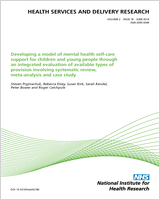Included under terms of UK Non-commercial Government License.
NCBI Bookshelf. A service of the National Library of Medicine, National Institutes of Health.
O’Cathain A, Knowles E, Turner J, et al. Explaining variation in emergency admissions: a mixed-methods study of emergency and urgent care systems. Southampton (UK): NIHR Journals Library; 2014 Dec. (Health Services and Delivery Research, No. 2.48.)

Explaining variation in emergency admissions: a mixed-methods study of emergency and urgent care systems.
Show detailsI want you to think about emergency admissions that can be avoided if an emergency and urgent care system works well. By that I mean that the right services are in place, working in a coordinated and integrated way, to ensure that people experiencing an acute episode who don’t need to be admitted to hospital are not admitted. Services might include GP, GP OOH, ambulance, social services, EDs, community health services, NHS Direct – I would like you to think widely.
1. Here’s a list of conditions that have been identified by an expert panel as sometimes avoidable if a system is working well. Prompt with a card listing conditions. Do you have any comments about this list . . . are these the types of conditions that you would expect to see?
2. Thinking about helping people with an acute episode of these conditions to avoid a hospital admission
(i) What works well in the area you serve (i.e. PCT or hospital catchment area)
Prompts:
Presence of services (services that help reduce avoidable admissions)
Well performing services (services that meeting targets/operate safely)
Service integration or coordination (services that work together well)
Awareness of services by doctors/nurses or patients/public
Good accessibility to services (opening hours, location, capacity)
(ii) What does not work well in your locality?
Prompts:
Missing services (e.g. any services that you feel are important but are not currently operational in your locality)
Poor services (e.g. underperforming services, unsafe services)
Integration of services (e.g. services that could, but don’t work together)
Poor awareness of services by health professionals or patients
Lack of accessibility to services (opening hours, location, capacity)
3. Thinking about your organisation (prompt with appropriate term)
(i) What works well in avoiding emergency admissions?
(ii) What does not work well in avoiding emergency admissions?
4. You have discussed a range of issues (problems/solutions) affecting avoidable emergency admissions in your locality/service.
(i) Which solution has had the most impact?
(ii) Which solution could have the most impact?
5. Is there anything else that you’d like to say about avoidable emergency admissions?
The study is due to be completed in February 2014. If you would like to see a summary of the findings I would be happy to forward them on to you. Would you like me to do this?
Thank you for your time.
- Topic guide for interviews - Explaining variation in emergency admissions: a mix...Topic guide for interviews - Explaining variation in emergency admissions: a mixed-methods study of emergency and urgent care systems
Your browsing activity is empty.
Activity recording is turned off.
See more...